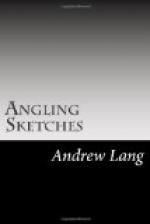Now, all lochs have their humours. In some trout like a big fly, in some a small one, but almost all do best with a rough wind or rain. I knew enough of Loch Beg to approach it at noon on a blazing day of sunshine, when the surface was like glass. It was like that when first I saw it, and a shepherd warned us that we “would dae naething”; we did little, indeed, but I rose nearly every rising fish I cast over, losing them all, too, and in some cases being broken, as I was using very fine gut, and the fish were heavy. Another trial seemed desirable, and the number of rising trout was most tempting. All over it trout were rising to the natural fly, with big circles like those you see in the Test at twilight; while in the centre, where no artificial fly can be cast for want of a boat, a big fish would throw himself out of the water in his eagerness. One such I saw which could not have weighed under three pounds, a short, thick, dark-yellow fish.
I was using a light two-handed rod, and fancied that a single Test-fly on very fine tackle would be the best lure. It certainly rose the trout, if one threw into the circle they made; but they never were hooked. One fish of about a pound and a half threw himself out of the water at it, hit it, and broke the fine tackle. So I went on raising them, but never getting them. As long as the sun blazed and no breeze ruffled the water, they rose bravely, but a cloud or even a ripple seemed to send them down.
At last I tried a big alder, and with that I actually touched a few, and even landed several on the shelving bank. Their average weight, as we proved on several occasions, was exactly three-quarters of a pound; but we never succeeded in landing any of the really big ones.
A local angler told me he had caught one of two pounds, and lost another “like a young grilse,” after he had drawn it on to the bank. I can easily believe it, for in no loch, but one, have I ever seen so many really big and handsome fish feeding. Loch Beg is within a mile of a larger and famous loch, but it is infinitely better, though the other looks much more favourable in all ways for sport. The only place where fishing is easy, as I have said, is a mere strip of coast under the hill, where there is some gravel, and the mouth of a very tiny feeder, usually dry. Off this place the trout rose freely, but not near so freely as in a certain corner, quite out of reach without a boat, where the leviathans lived and sported.




